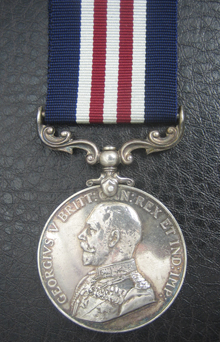
MILITARY MEDAL, G.V.R. ‘634 AR: SJT: G. HARRY. 26/AUST: INF: BN:’
M.M. London Gazette 21 September 1916.
The original recommendation (for a D.C.M.) states: ‘Previous to the attack on the 4th August 1916, Sergeant Harry although a non-combatant put in a strong plea to take part in the attack. The O.C. Battalion Dump became a casualty on the way up and Sergeant Harry took over his job. Despite the fact that he was once completely buried and later was severely shaken by a high explosive shell he stuck to his job gamely for the 50 hours during which his Battalion occupied the trenches. He personally acted as guide for carrying parties across the open from the dump to the captured trenches on many occasions at great personal risk. In all his duties in the attack on Pozieres Ridge he showed great courage and control.’
M.M. London Gazette 1 January 1918.
The original recommendation states: :‘Lieut. Harry as Intelligence Officer of the 7th A.I. Brigade during eight days prior to the attack on 20.9.17 on Westhoek Ridge, was occupied reconnoitring the front over which the attack was to be made, and in noting the enemy barrages. This work entailed being constantly under heavy enemy shell fire almost continuously. His courage and devotion to duty cannot be too highly spoken of. As a result of his plucky and clever reconnaissance, Battalions were assembled for the attack in forward positions where they were immune from hostile shelling, and up to the time of their actually taking part in the assault, these Battalions suffered no casualties. It is certain that but for this reconnaissance, many casualties would have occurred during the assembly of these Battalions while they waited to go over.’
M.C. Second Award Bar London Gazette 7 November 1918.
The original recommendation states: ‘During the operations on the 11th August 1918, South of Framerville, near Amiens, the situation on the right flank was very obscure. Lieut. Harry went forward right out into the gap between the Right Battalion of this Brigade and the Left Battalion of the neighbouring Division, under heavy machine gun and rifle fire. In spite of the enemy barrage, he proceeded to within 100 yards of the Hun posts, and though his clothing was pierced by enemy weapons fire, he went on and obtained information required. He showed remarkable courage and determination.’
Gilbert Harry, aged 24, by trade a Gunsmith, of ‘Brae Lossie’, Prospect Terrace, South Brisbane, enlisted in the 26th Battalion, Australian Imperial Force, 13 May 1915. Details of his rank on joining and immediate promotions are not noted but it appears he was appointed the rank of Armoury Sergeant pretty much straight away. Landing at Gallipoli on 12 September 1915, on 16 September, Harry transferred to Ordnance, ANZAC, serving in this post until 30 September when he returned to his Battalion. After a period in hospital; 17-26 October, it seems he was then posted back to Ordnance, ANZAC, remaining there until disembarking at Alexandria with 26 Battalion in January 1916. Landing in France on 21 March 1916, on 21 May 1916, he was temporarily attached to Divisional Armoury. Commissioned Temporary 2nd Lieutenant, 16 August 1916, in September he was awarded the Military Medal ‘for services rendered during the recent fighting at Pozieres’ and at the same time is noted as doing duty as 7th Brigade Sniping Officer. Promoted Lieutenant on 9 December 1916, between 13 February and 6 March 1917, he attended the Staff Course at Clare College (England) before joining Headquarters, 7th Infantry Brigade in France as Intelligence Officer. Wounded in action, 4 October 1917 (face), he remained on duty but a week later received leave and rejoined Headquarters, 7th Infantry Brigade on the 29 October. Awarded the Military Cross on 1 January 1918 for his actions during the Battle of Menin Road, Ypres, September 1917.
Remaining as 7th Infantry Brigade in France as Intelligence Officer, on 19 July 1918, he was temporarily attached as ADC to General Officer Commanding 2nd Division, before returning to Brigade Headquarters the following month. Wounded again on 1 September 1918 (shell splinters), he remained on duty but had a weeks leave to Paris from September 30, having been appointed Temporary Captain on 19 September. On 8 November 1918, he was awarded the Bar to his Military Cross, for gallantry during the battle of Amiens in August that year, becoming one of just nine Australians awarded this combination of awards for WW1.
Captain Harry returned to Australia in July 1919 and was discharged from the Army in September that year. A medical report noting him having suffered shell splinters ion various parts of the body, a wound to his nose and having been gassed on a number of occasions but had never been evacuated. At this time he was still suffering with a chronic cough, hoarseness and short winded palpitations from the ‘effects of gassing – lungs’.
Post War, Harry was unable to work his land due to his various injuries and moved to Gympie in Queensland and became a dairy farmer, though not successfully. Suffering much from the effects of the gas attacks and depression, March 1931, he took his own life. Aged just 37, he was buried in an unmarked paupers grave in Gympie . 78 years later, after an investigation by the RSL, a memorial service to this brave man was held and headstone was finally added to his grave.
An excellent article on Harry, including much about his later left can be found here:
https://discoveringanzacs.naa.gov.au/browse/person/193837
Condition GVF. Sold with copied service papers, recommendations etc. Ex Spink 2008 (£2600 hammer). Captain Harry’s medals, minus the MM, are displayed in the Gympie RSL Club. He was just one of just nine Australians awarded this combination of awards for WW1
A quite outstanding Australian M.M. for the Great War.